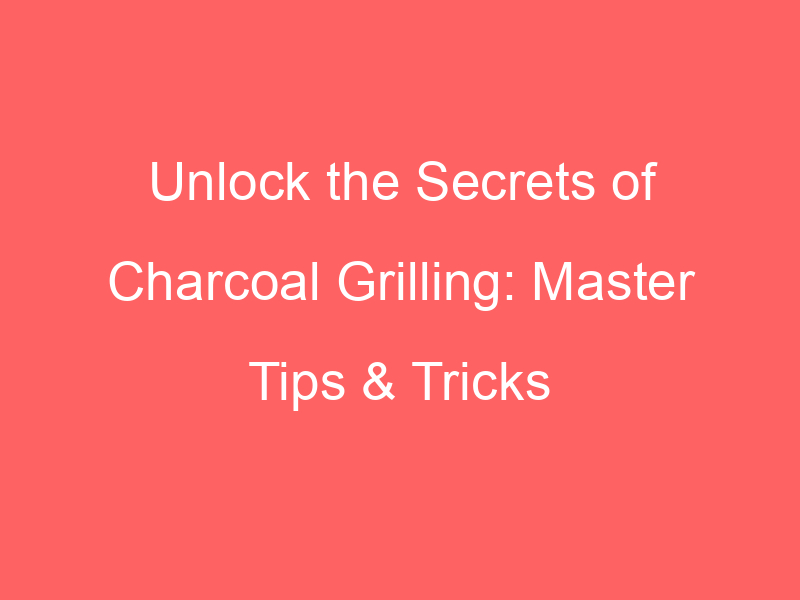Introduction to Charcoal Grilling Techniques
Grilling is an art, and like any art, it requires practice and understanding of its basics. Among the various grilling methods, charcoal grilling stands out for its unique flavor and authenticity. Let’s delve into the world of charcoal grilling and learn why it’s a favorite among many.
-
Understanding the Basics of Charcoal Grilling
Charcoal grilling is a traditional cooking method that uses charcoal briquettes or lump charcoal as fuel. The heat from the burning charcoal cooks the food, and the smoke adds a distinct flavor that is hard to replicate with other cooking methods. The basic steps include lighting the charcoal, setting up the grill, controlling the temperature, and mastering the cooking times for different foods.
-
Why Choose Charcoal Grilling Over Other Methods
Charcoal grilling is preferred by many for its ability to impart a smoky flavor that enhances the taste of the food. It also offers a high-heat cooking method, ideal for searing meat to perfection. Unlike gas grills, charcoal grills are portable and less expensive. They also allow for a more hands-on grilling experience, which many grill enthusiasts enjoy.
-
Benefits of Mastering Charcoal Grilling
Mastering charcoal grilling techniques can elevate your cooking skills to new heights. It allows you to control the flavor and texture of your food, making your dishes more enjoyable. It also provides a fun and rewarding outdoor cooking experience. Plus, it’s a great way to impress your friends and family at your next BBQ party!
Now that we’ve covered the basics, let’s move on to some essential grilling tips, tricks to enhance flavor and efficiency, and advanced techniques. By the end of this guide, you’ll be well on your way to becoming a charcoal grill master.
The Art of Grilling: Essential Grilling Tips
Grilling is an art that requires both skill and knowledge. One of the most crucial aspects of grilling is choosing the right charcoal. The type of charcoal you use can greatly affect the taste and quality of your BBQ.
Choosing the Right Charcoal
Choosing the right charcoal for your BBQ is not as simple as it may seem. There are several factors to consider, including the type of charcoal and its quality. Let’s delve into these aspects in more detail.
-
- Types of Charcoal
There are two main types of charcoal: lump charcoal and briquettes. Lump charcoal is made from hardwood and is known for its ability to reach high temperatures quickly. It also imparts a smoky flavor to the food. On the other hand, briquettes are made from a mixture of wood and other materials. They burn longer and more consistently than lump charcoal, but they do not reach as high temperatures.
-
- Choosing the Best Charcoal for Your BBQ
When choosing the best charcoal for your BBQ, consider what you will be grilling. If you’re grilling foods that cook quickly, like burgers or hot dogs, lump charcoal is a good choice because of its ability to reach high temperatures quickly. If you’re grilling foods that take longer to cook, like ribs or brisket, briquettes are a better choice because they burn longer and more consistently. Always choose high-quality charcoal, as it will burn better and impart a better flavor to your food.
In conclusion, the art of grilling involves more than just throwing food on the grill. It requires careful consideration of the type and quality of charcoal you use. By understanding the differences between lump charcoal and briquettes and knowing when to use each, you can elevate your grilling skills and impress your friends and family at your next BBQ.
Setting up Your Charcoal Grill
Setting up your charcoal grill is a crucial step in the grilling process. It not only impacts the quality of your food but also ensures safety during cooking. Here, we will guide you on proper grill placement and safe lighting methods.
-
- Proper placement of the grill
Where you place your grill matters a lot. It’s best to set up your grill in a well-ventilated area, away from flammable materials. It should be on a flat, stable surface to prevent it from tipping over. Avoid placing it under low hanging branches or close to wooden structures. This placement ensures that the smoke doesn’t accumulate and pose a health risk, and it also reduces the risk of fire accidents.
-
- How to safely light your Charcoal Grill
Safety should always be your priority when lighting your charcoal grill. Start by arranging your charcoal in a pyramid shape at the center of the grill. This arrangement allows for better air circulation, which aids in even burning. Then, light the charcoal using a long match or a long-nose lighter to keep your hand away from the flame. Once the charcoal is lit, cover the grill and let the charcoal burn until it’s covered with white-gray ash. At this point, you can spread out the coals and start grilling.
Remember, grilling is an art that requires patience and practice. With these tips, you’re well on your way to becoming a master griller. Happy grilling!
Charcoal BBQ Tricks: Enhancing Flavor and Efficiency
Charcoal grilling is an art that requires practice and understanding. One of the key aspects to master is temperature control. By understanding heat zones and learning how to adjust grill vents, you can enhance both the flavor and efficiency of your grilling.
Mastering Temperature Control
Temperature control is crucial for perfect grilling. It determines how well your food is cooked and the flavors that are brought out. Let’s break it down into two main parts: understanding heat zones and adjusting grill vents.
- Understanding Heat Zones
Every grill has different heat zones. These are areas of varying temperature that you can use to cook different types of food. The hottest zone is directly above the coals, perfect for searing meat. The medium zone is a bit further away, ideal for cooking vegetables and fish. The coolest zone is furthest from the coals, great for slow cooking and smoking.
- How to Adjust Grill Vents for Temperature Control
Grill vents are another tool for controlling temperature. They allow air to flow in and out of the grill, which affects the heat of the coals. To increase the temperature, open the vents to let more oxygen in. To decrease the temperature, close the vents slightly. Remember, never close the vents completely, as this can cause the coals to go out.
Mastering temperature control can take your grilling to the next level. It allows you to cook a variety of foods perfectly and brings out the best flavors. So, the next time you fire up your charcoal grill, remember these tips and enjoy the delicious results!
Adding Flavor with Smoke
One of the most exciting aspects of charcoal grilling is the ability to infuse your food with a unique, smoky flavor. This flavor can be adjusted and enhanced by using different types of wood for smoking and by mastering the use of wood chips in a charcoal grill.
-
- Choosing the right wood for smoking
Not all woods are created equal when it comes to smoking. The type of wood you choose can have a significant impact on the flavor of your food. Hardwoods like oak, hickory, and mesquite are popular choices for their strong, distinct flavors. Fruitwoods like apple and cherry can provide a sweeter, more subtle flavor. It’s important to experiment with different types of wood to find the flavor profile that suits your taste best.
-
- How to use wood chips in a Charcoal Grill
Using wood chips in a charcoal grill can seem daunting, but with a few simple steps, you can easily master this technique. First, soak your wood chips in water for about 30 minutes before grilling. This helps the chips to smolder and produce smoke rather than burning up quickly. Next, drain the chips and place them directly on the hot coals. The smoke produced by the smoldering wood chips will infuse your food with a delicious smoky flavor. Remember, the key is to add the chips gradually and maintain a steady temperature for the best results.
In conclusion, adding smoke to your charcoal grilling can elevate your BBQ to the next level. By choosing the right wood and mastering the use of wood chips, you can create a flavor experience that is truly unique and delicious. Happy grilling!
Perfect Charcoal Grilling: Advanced Techniques
As we delve deeper into the art of charcoal grilling, we will explore advanced techniques that can elevate your grilling game. One such technique is learning how to grill different types of food. This is a critical skill as different foods require different grilling methods.
Grilling Different Types of Food
Whether you’re grilling meat or vegetables, each type of food has its own unique set of grilling requirements. Let’s take a closer look at how to grill meat and vegetables on a charcoal grill.
-
- How to Grill Meat on a Charcoal Grill
Grilling meat on a charcoal grill is a skill that requires practice and understanding. Here are some key steps:
-
-
- Preheat your grill: Allow the charcoal to burn until it turns white-hot. This usually takes about 15-20 minutes.
- Season your meat: While your grill is preheating, season your meat. A simple seasoning of salt and pepper can enhance the flavor of the meat.
- Place the meat on the grill: Once the grill is preheated, place your meat on the grill. Remember to turn the meat occasionally to ensure it cooks evenly.
- Check for doneness: Use a meat thermometer to check if your meat is cooked to your desired level of doneness.
- Grilling Vegetables and Other Non-Meat Items
-
Grilling vegetables and other non-meat items can be a great way to add variety to your grilling repertoire. Here’s how:
-
- Choose the right vegetables: Not all vegetables are suitable for grilling. Some good options include bell peppers, zucchini, asparagus, and corn on the cob.
- Prep your vegetables: Cut your vegetables into large, flat pieces that won’t fall through the grill grates. Coat them lightly in oil to prevent sticking.
- Grill your vegetables: Place your vegetables on the grill. Turn them occasionally to ensure they cook evenly.
- Check for doneness: Vegetables should be tender and slightly charred when done.
Remember, practice makes perfect. The more you grill, the better you’ll get at it. So, don’t be afraid to experiment and try grilling different types of food. Happy grilling!
Common Mistakes to Avoid
While mastering the art of charcoal grilling, it’s equally important to be aware of the common mistakes that can hinder your progress. Let’s take a look at some of them:
-
- Overcrowding the grill
One of the most common mistakes made by beginners is overcrowding the grill. It might be tempting to load up the grill with all your favorite foods, but this can lead to uneven cooking. When the grill is overcrowded, the heat can’t circulate properly. This means some parts of your food might be undercooked while others are burnt. A good rule of thumb is to leave at least 30% of your grill empty. This allows for better heat distribution and gives you space to move food around as needed.
-
- Not letting the grill preheat properly
Another common mistake is not allowing the grill to preheat properly. Preheating your grill is crucial for achieving that perfect sear and delicious grilled flavor. If you put your food on the grill before it’s hot enough, it can stick to the grates and tear when you try to flip it. It also won’t get that nice, crispy exterior that we all love. Most experts recommend preheating your grill for at least 15 minutes before you start cooking.
By avoiding these common mistakes, you can ensure that your grilling experience is a success. Remember, practice makes perfect, so don’t be discouraged if you make a few mistakes along the way. Happy grilling!
Grilling with Charcoal: Case Studies
Let’s delve into real-life examples to better understand the art of charcoal grilling. These case studies will provide practical insights into achieving the perfect grilling results.
Case Study 1: Achieving the Perfect Steak
Grilling the perfect steak is an art that requires patience, skill, and the right technique. Let’s explore how John, a home cook, mastered this skill using a charcoal grill.
John started his grilling journey with a simple goal: to grill the perfect steak for his family. He had a basic charcoal grill and a desire to learn. He began by selecting the right cut of meat, a prime rib-eye steak, known for its marbling and flavor.
| Key Steps | Description |
|---|---|
| Preparation | John seasoned his steak with salt and pepper, allowing it to rest at room temperature for about an hour before grilling. |
| Grill Setup | He arranged the charcoal for indirect grilling, creating a hot zone for searing and a cooler zone for slower cooking. |
| Cooking | John first seared the steak on the hot zone for about 2 minutes on each side. Then, he moved it to the cooler zone, covering the grill and letting it cook for about 10 minutes until it reached his desired doneness. |
| Resting | After grilling, John let the steak rest for a few minutes to allow the juices to redistribute throughout the meat. |
John’s efforts paid off. His family praised the steak for its perfect sear, juicy interior, and rich flavor. This case study demonstrates that with the right technique and a bit of practice, anyone can achieve the perfect steak on a charcoal grill.
Case Study 2: Grilling a Whole Chicken
Grilling a whole chicken on a charcoal grill can seem like a daunting task, but with the right techniques, it can be done with ease. Let’s explore a case where a novice griller successfully grilled a whole chicken using a charcoal grill.
Step 1: Preparation
Our novice griller started by preparing the chicken. He removed the giblets, rinsed the chicken, and patted it dry. He then seasoned it with a simple mix of salt, pepper, and olive oil.
Step 2: Setting up the Grill
He set up his charcoal grill for indirect grilling. This means he placed the charcoal on one side of the grill, leaving the other side empty. This setup allows the chicken to cook slowly and evenly without burning.
Step 3: Grilling the Chicken
He placed the chicken on the grill, breast side up, on the side without the charcoal. He covered the grill and let the chicken cook for about 1.5 hours. He checked the temperature of the chicken every 20 minutes to ensure it was cooking evenly.
Step 4: Checking the Doneness
After 1.5 hours, he checked the chicken’s internal temperature with a meat thermometer. The temperature in the thickest part of the thigh was 165°F, indicating that the chicken was fully cooked.
Step 5: Resting and Serving
He removed the chicken from the grill and let it rest for 15 minutes before carving and serving. The result was a perfectly grilled chicken with a crispy skin and juicy meat.
| Step | Action | Key Takeaway |
|---|---|---|
| 1 | Preparation | Properly preparing the chicken ensures it cooks evenly and tastes great. |
| 2 | Setting up the Grill | Setting up the grill for indirect grilling prevents the chicken from burning. |
| 3 | Grilling the Chicken | Regularly checking the temperature ensures the chicken cooks evenly. |
| 4 | Checking the Doneness | Using a meat thermometer ensures the chicken is fully cooked. |
| 5 | Resting and Serving | Resting the chicken before carving keeps it juicy and flavorful. |
In conclusion, grilling a whole chicken on a charcoal grill is not as difficult as it seems. With the right preparation, setup, and grilling techniques, anyone can achieve a perfectly grilled chicken.
Charcoal Grill Mastery: Key Takeaways
As we reach the end of our journey into the world of charcoal grilling, let’s take a moment to recap the key insights and techniques we’ve learned. These takeaways will not only enhance your grilling skills but also pave the way for your next steps in this exciting culinary journey.
- Recap of Charcoal Grilling Techniques
We started with the basics, understanding the importance of choosing the right charcoal and how to light it properly. We then delved into mastering the heat, learning how to control the temperature for different types of food. We also explored the art of using direct and indirect grilling methods, and how to use them effectively for different dishes.
Our journey took us further into the world of flavor enhancement, where we discovered the magic of using wood chips for that added smoky flavor. We also learned about the importance of marinating and seasoning, and how these simple steps can transform your grilling experience.
Finally, we tackled some advanced techniques, such as the ‘reverse sear’ method for perfect steaks and the ‘low and slow’ method for tender ribs. We also looked at some case studies, learning from the experiences of seasoned grill masters.
- Next Steps in Your Grilling Journey
Now that you’ve mastered the basics and learned some advanced techniques, it’s time to take your grilling skills to the next level. Experiment with different types of food, try new marinades and seasonings, and don’t be afraid to make mistakes. Remember, practice makes perfect.
Consider joining a local grilling club or online community where you can share your experiences and learn from others. You might also want to explore other types of grills, such as gas or pellet grills, to broaden your grilling horizons.
Remember, the journey to charcoal grill mastery doesn’t end here. It’s a continuous process of learning, experimenting, and most importantly, enjoying the delicious results of your hard work. Happy grilling!






